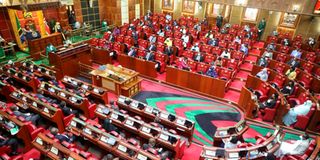The 12 independents at the centre of Raila, Ruto fight for House

A joint sitting of parliament on May 5, 2021. The battle for the control of Parliament is on a knife’s edge with Raila Odinga’s Azimio la Umoja One Kenya Coalition leading in the National Assembly and Deputy President William Ruto’s Kenya Kwanza Alliance ahead in the Senate.
What you need to know:
- The battle for the control of the 349-member National Assembly, where Azimio boasts a 162-159 advantage, could boil down to the 12 independent MPs.
- Whichever way the 12 independents cast their lot may guarantee a confirmed majority for Azimio, or tilt the tables in favour of Kenya Kwanza.
- While the National Assembly swings in favour of Azimio, Kenya Kwanza has control of the Senate, but by just one member.
The battle for the control of Parliament remained on a knife’s edge last night as a tabulation of declared results showed a neck-and-neck race, with Raila Odinga’s Azimio la Umoja One Kenya Coalition leading in the National Assembly and Deputy President William Ruto’s Kenya Kwanza Alliance ahead in the Senate.
With the Senate split 24-23 in favour of Kenya Kwanza, the battle for the control of the 349-member National Assembly, where Azimio boasts a 162-159 advantage, could boil down to the 12 independent MPs.
An independent MP is one who is elected free of any political party backing and is in fact required to have resigned from any party at least three months to the polls to be eligible to vie.
But while they are, by design, required not to associate with any outfit, independent candidates have often aligned with parties or coalitions they either contested in during the nominations or see as being closer to their ideology.
Whichever way the 12 independents cast their lot may guarantee a confirmed majority for Azimio, or tilt the tables in favour of Kenya Kwanza.
This is because the 12 nominated seats, given the strength of the coalitions, could be an even split, or one coalition just a member or two more.
Full list
The single-member constituency MPs elected as independents are Rahim Dawood (Imenti North), Ronald Karauri (Kasarani), Elijah Njoroge (Gatundu North), Shakeel Shabbir (Kisumu East), Timothy Toroitich (Marakwet West), Joshua Mwalyo (Masinga), Nebert Muriuki (Mbeere South), Geoffrey Mulanya (Nambale) and Kitilai Ntutu (Narok South).
On the Woman Rep front, those elected as independents are Migori’s Fatuma Mohamed, Caroline Ngelechei (Elgeyo-Marakwet), and Monica Muthoni (Lamu).
Mr Karauri and Ms Mohamed had affiliated with Azimio before the polls, while Mr Toroitich, Mr Ntutu and Ms Ngelechei had backed Kenya Kwanza.

Kasarani Constituency MP-elect Ronald Karauri arrives at Clay City Secondary School polling station, to cast his vote on August 9, 2022.
In 2017, the National Assembly had 13 independent members – the fourth largest group after Jubilee, ODM and Wiper, in that order.
For a clearer comparison, the independents in 2017 beat MPs sponsored by Mr Musalia Mudavadi’s Amani National Congress (12), while Moses Wetang’ula’s Ford-Kenya had 10.
Of the 13, six had participated in the party nominations. They are Mohamed Ali (Nyali), John Paul Mwirigi (Igembe South), Kawira Mwangaza (Meru County), Patrick Wainaina (Thika Town), Janet Sitienei (Turbo) and Peter Masara (Suna West).
Mr Ali, Mr Mwirigi, Mr Wainaina and Ms Sitienei later joined Dr Ruto, while Mr Masara joined ODM, as Ms Mwangaza has now been elected as an independent governor of Meru.
In all, Azimio has 162 against Kenya Kwanza’s 159 MPs in the National Assembly.
Four constituencies – Rongai, Kacheliba, Pokot South and Kitui Rural – had their polls postponed due to ballot papers mix-up.
In Azimio, ODM has 86, Jubilee (27), Kalonzo Musyoka’s Wiper (24), Democratic Action Party-Kenya (5), outgoing Baringo Senator Gideon Moi’s Kanu (5), outgoing Mandera Governor Ali Roba’s UDM (5) and United Party of Independent Alliance, UPIA (2).
Those with one MP each are former Lugari MP Cyrus Jirongo’s United Democratic Party (1), United Progressive Alliance, GDDP, Movement for Democracy and Growth, KUP, National Ordinary People Empowerment Union as well as National Alliance Party of Kenya.
Kenya Kwanza, on the other hand, is heavily tilted towards UDA, with 116 MPs and 21 woman representatives.
Others are ANC (7), Ford-Kenya (6), Kilifi Governor Amason Kingi’s Pamoja African Alliance (3), Machakos Governor Alfred Mutua’s Maendeleo Chap Chap (2), National Assembly Speaker Justin Muturi’s Democratic Party (1), ex-Bomet Governor Isaac Ruto’s Chama Cha Mashinani (1) and former Agriculture Cabinet Secretary Mwangi Kiunjuri’s The Service Party (1).
Kenya Kwanza also leads in terms of women representatives – women MPs elected in each of the 47 constituencies – with 24 against Azimio’s 20. Three women representatives were elected as independents.
Senate numbers
While the National Assembly swings in favour of Azimio, Kenya Kwanza has control of the Senate, but by just one member. It has 24 senators against Azimio’s 23.
A total of 20 senators – 16 women, two youth and two to represent persons with disability – will be nominated to the House based on party strength to bring its total to the constitutional 67.
In the last Parliament, President Uhuru Kenyatta’s Jubilee, before Dr Ruto ditched it to form UDA, had 38 of the 67 senators.
These were Jubilee’s 24 elected senators and 10 nominated, while its affiliates Kanu had three (two elected, one nominated), and Party for Development and Reforms had one
Mr Odinga’s National Super Alliance (Nasa), on the other hand, had 28 senators.
These were ODM’s 20 (15 elected, five nominated), Wiper’s three (two elected, one nominated), ANC three (two elected, one nominated), Chama Cha Uzalendo (1) and Ford-Kenya (1). Kirinyaga’s Charles Kibiru was elected as an independent.
In the Council of Governors, Kenya Kwanza and Azimo are tied at 21 each. There are two independent governors, Ms Mwangaza (Meru) and Taita-Taveta’s Andrew Mwadime.
The Kakamega and Mombasa gubernatorial races were postponed due to ballot papers mix-up. Like the four constituencies whose polls were postponed, they will hold their by-elections on August 23.
The numbers in Parliament, especially, are an important indicator; a president commanding the majority enjoys the legroom to implement his policies and programmes but would be severely hamstrung if in a minority.
In the last Parliament, Jubilee was just 32 MPs shy of the absolute majority, before the disintegration that saw Dr Ruto hive off a chunk of the outfit to form UDA.
Jubilee had 172 MPs, but its strength rose to 200 with the support of Kanu (10), Economic Freedom Party (5), Party for Development and Reform (4), Maendeleo Chap Chap (4), Kenya National Congress (2) and PNU (1).
On the minority benches, ODM had 73, Wiper (23), ANC (14), Ford-Kenya (13), Chama Cha Mashinani (2) and Chama Cha Uzalendo (1). The other small parties had one each.





